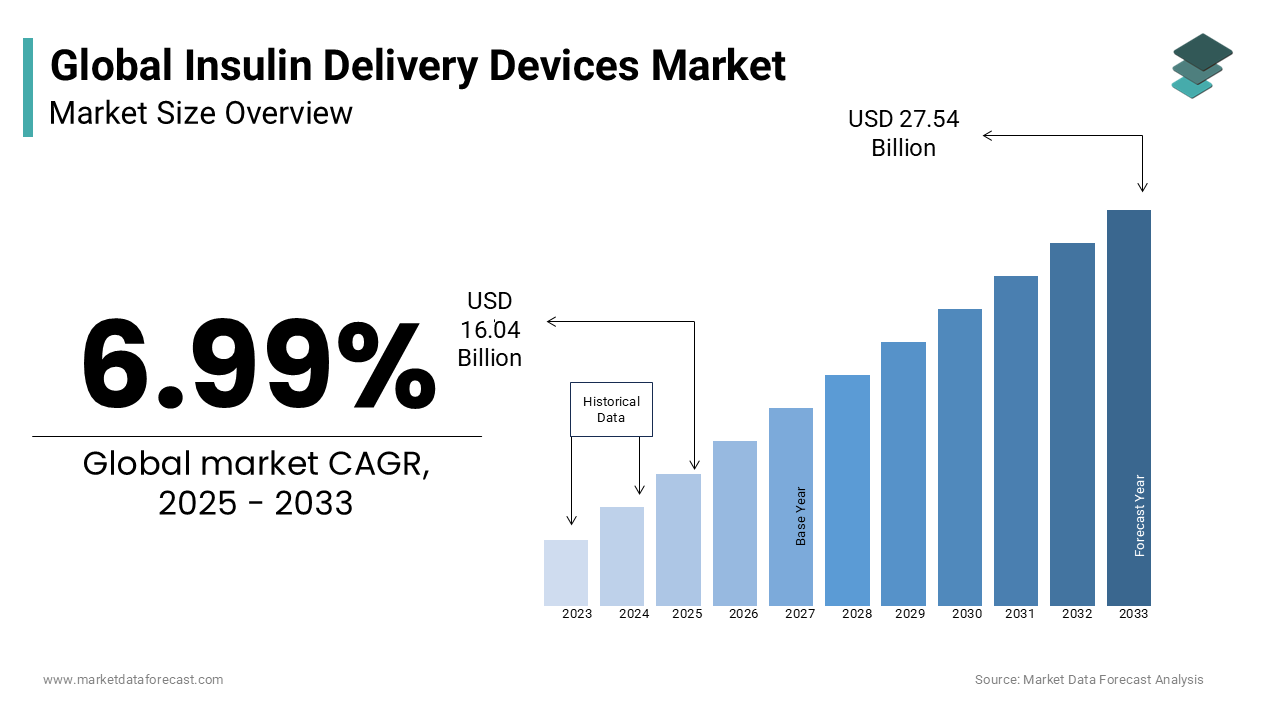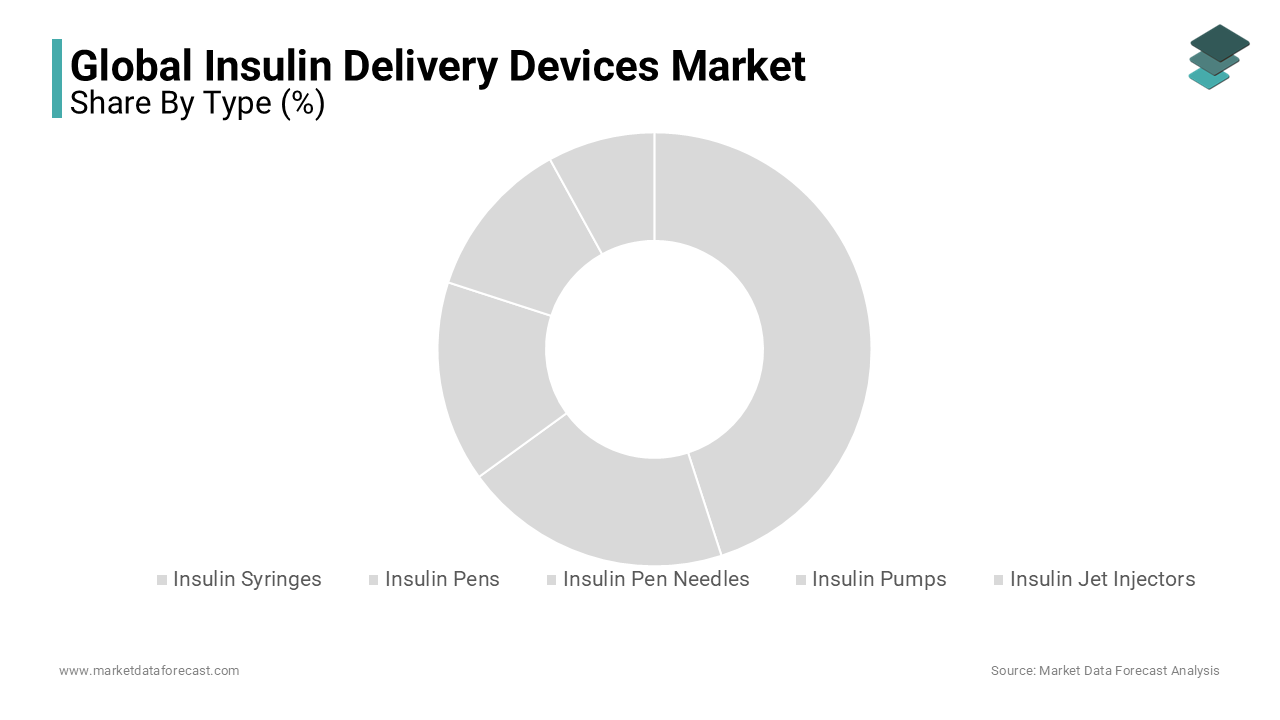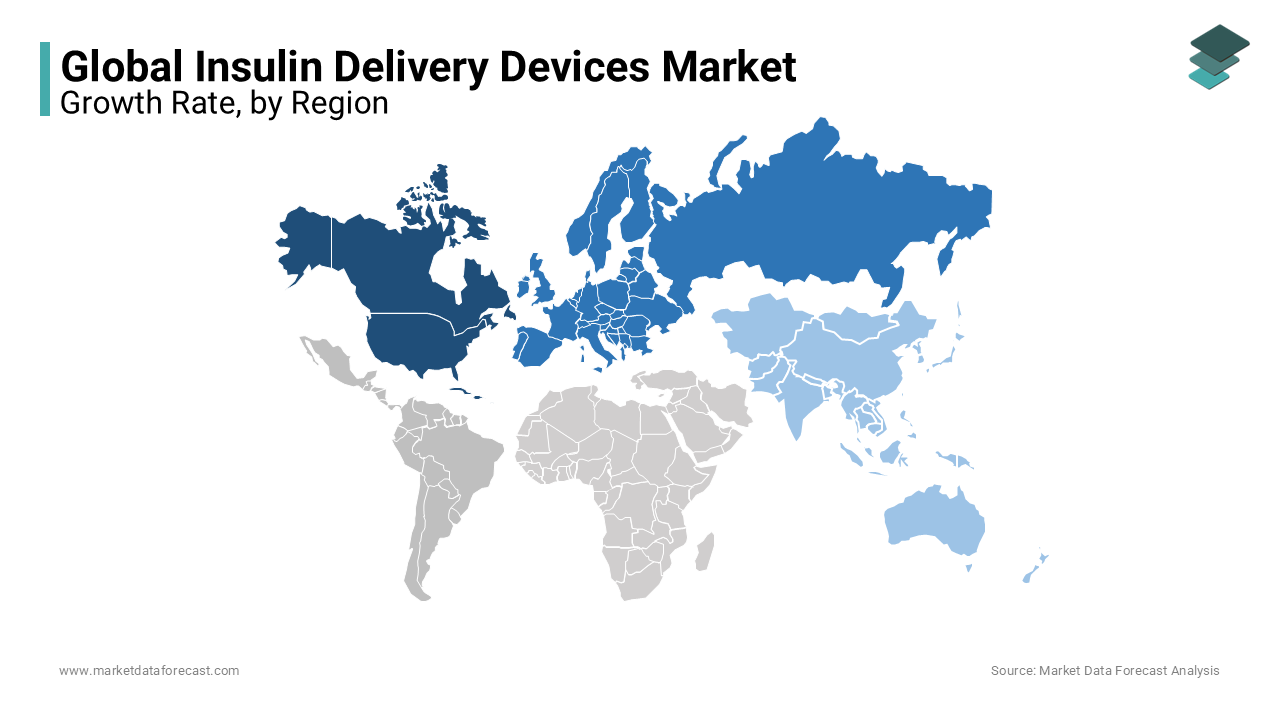Global Insulin Delivery Devices Market Size, Share, Trends & Growth Analysis Report - By Type (Insulin Syringes, Insulin Pens, Insulin Pen Needles, Insulin Pumps, Insulin Jet Injectors), By Application (Type I Diabetes & Type II Diabetes) and Region – Industry Analysis From 2025 to 2033
Global Insulin Delivery Devices Market Size
As per our report, the global insulin delivery devices market size was valued at USD 14.99 billion in 2024. The insulin delivery devices market size is forecasted to grow to USD 27.54 billion by 2033 from USD 16.04 billion in 2025, growing at a CAGR of 6.99% from 2025 to 2033.

MARKET DRIVERS
The growing prevalence of diabetes due to obesity majorly drives the growth of the insulin delivery devices market.
As per the statistics published by the Centers for Disease Control and Prevention (CDC), around 37.3 million are living with diabetes, which is 11.3% of the total population of the United States and about 422 million people worldwide with diabetes, with the majority of sufferers living in low-income nations, according to WHO figures. Every year, diabetes causes roughly 1.5 million fatalities. About 9 million persons were given a type 1 diabetes diagnosis in 2019; most of them were from high-income nations. On the other hand, type 2 diabetes predominates globally, accounting for around 95% of all cases. The need for insulin delivery devices is directly proportional to the increasing patient population suffering from diabetes.
Technological advancements in insulin delivery devices, such as smart insulin pens and insulin pumps and growing support from the USFDA further contribute to the global market growth. For instance, The FDA approved the first generation's MiniMed 530G artificial pancreas in 2013. In addition, the FDA gave Medtronic's MiniMed 770G system, a hybrid closed-loop diabetes management device, its approval on September 1st, 2020. With the invention of this new insulin delivery method, the procedure is now simpler than before, promoting the demand for the market.
Growing consumer awareness of the availability of several delivery devices, the rising prevalence of hyperglycemia, increasing awareness about diabetes management and the importance of insulin delivery devices and rapid adoption of insulin therapy for diabetes management drives the insulin delivery devices market growth. The growing geriatric population who are more prone to diabetes and require insulin administration, favorable reimbursement policies for insulin delivery devices in some healthcare systems and rising F.D.A. support boost the insulin delivery devices market growth.
The rising demand for minimally invasive and painless insulin delivery options, growing incidence of obesity, a major risk factor for developing diabetes, improving healthcare infrastructure and access to diabetes care in developing regions and rising emphasis on improving insulin delivery accuracy and dosage control further fuel the growth rate of the insulin delivery devices market. Innovations in needle technologies, including shorter and finer needles for improved patient comfort, growing preference for insulin pens due to their ease of use and convenience, integration of insulin delivery devices with digital platforms and mobile applications for remote monitoring and management, increasing investments in research and development for advanced insulin delivery technologies and expansion of product portfolios by key market players favor the growth of the insulin delivery devices market.
MARKET RESTRAINTS
High costs associated with insulin delivery devices, limiting affordability for some patients, limited reimbursement coverage for certain types of insulin delivery devices and stringent regulatory requirements and approval processes for new insulin delivery devices majorly hamper the global market growth. Fear or resistance to adopting new technologies among healthcare professionals and patients, risk of device-related complications, such as infection or device malfunction and limited availability and accessibility of insulin delivery devices in certain regions or healthcare settings hinder the market growth. Lack of patient education and awareness about the benefits and proper use of insulin delivery devices, challenges in integrating insulin delivery devices with existing diabetes management systems and electronic health records and limited customization options for insulin delivery devices to meet individual patient needs further impede the market growth.
REPORT COVERAGE
|
REPORT METRIC |
DETAILS |
|
Market Size Available |
2024 to 2033 |
|
Base Year |
2024 |
|
Forecast Period |
2025 to 2033 |
|
Segments Covered |
By Type, Application, and Region |
|
Various Analyses Covered |
Global, Regional & Country Level Analysis, Segment-Level Analysis, Drivers, Restraints, Opportunities, Challenges; PESTLE Analysis; Porter's Five Forces Analysis, Competitive Landscape, Analyst Overview of Investment Opportunities |
|
Regions Covered |
North America, Europe, Asia Pacific, Latin America, Middle East & Africa |
|
Market Leaders Profiled |
Becton & Dickinson and Company (U.S.), Sanofi (France), Novo Nordisk A/S (Denmark), Julphar (U.A.E.), Eli Lilly and Company (U.S.), Biocon Ltd. (India), Ypsomed AG (Switzerland), Wockhardt Ltd. (India), B. Braun Meselgen AG (Switzerland) and Biodel Inc. (U.S.) |
SEGMENTAL ANALYSIS
By Type Insights
Based on type, the insulin pens segment was the leader among all types in 2024 and the domination of the insulin pens segment is likely to continue throughout the forecast period. The growing adoption due to their convenience, ease of use, and portability, accurate dosage delivery and customizable features for individual patient needs drive the growth of the insulin pens segment. The rising preference among patients and healthcare providers for discreet and convenient insulin administration, the availability of a wide range of insulin formulations compatible with pens and technological advancements, such as smart insulin pens further boost the growth rate of the segment.

The insulin syringes segment accounted for a substantial share of the global insulin delivery devices market in 2023 and is predicted to grow at a healthy CAGR during the forecast period. The continued usage of insulin syringes in regions with cost-conscious healthcare systems and limited access to newer devices and established market presence and familiarity among healthcare professionals and patients propel the growth of the insulin syringes segment. Affordable pricing compared to other insulin delivery options, the availability of different needle lengths and gauges to meet patient requirements and ongoing demand in certain healthcare settings, such as hospitals and clinics further accelerate the growth rate of the segment.
The insulin pen needles segment is anticipated to grow at a healthy rate during the forecast period. Factors such as the rapid adoption as a preferred needle option for insulin pens due to their improved comfort and reduced pain during injections and the compatibility with a wide range of insulin pens, offering flexibility for patients drive the growth of the insulin pen needles segment. Sharper and thinner needle designs for enhanced patient experience and growing awareness about the importance of proper needle disposal, promoting needle replacement and market growth contribute to the growth rate of the segment.
The insulin pumps segment is estimated to account for a considerable share of the global market during the forecast period due to the growing usage among individuals requiring intensive insulin therapy, such as those with type 1 diabetes and the advantages of continuous subcutaneous insulin infusion, providing precise and customizable insulin delivery. The growing focus on improving insulin pump technologies, including smaller form factors, longer battery life, and improved user interfaces and increasing demand for remote monitoring and data connectivity features in insulin pumps for better diabetes management further boost the growth rate of the segment.
Insulin Delivery Devices Market By Application
Based on the application, the Type II diabetes segment dominated the insulin delivery devices market in 2024 and is estimated to account for the largest share of the global market during the forecast period. Due to the numerous treatment options available for type 2 diabetic patients, there are varied applications for the condition leading to the segment's growth.
However, type 1 diabetes patients also use devices like insulin pumps, syringes, pens, and others to deliver a steady amount of insulin to the body. Additionally, the rise in type 1 diabetes diagnoses is expected to support the rise in the segment. The International Diabetes Federation (2017) estimates that each year in Europe, 28,000 children under the age of 19 are given a type 1 diabetes diagnosis. In addition, this market sector is expected d to be driven by increased access to insulin for type 1 diabetes in developed nations.
REGIONAL ANALYSIS

Geographically, the North American insulin delivery devices market accounted for 40.5% of the global market in 2023 and the domination of the North American region is most likely to continue throughout the forecast period. Factors such as the availability of well-established healthcare infrastructure, high adoption of advanced medical technologies, the presence of key market players and continuous research and development activities primarily drive the growth of the North American market. The growing prevalence of diabetes and related healthcare expenditure, favorable reimbursement policies and insurance coverage for insulin delivery devices and rising awareness among healthcare professionals and patients about the benefits of advanced insulin delivery technologies contribute to the growth of the North American market. The U.S. occupied the largest share of the North American market in 2023 and is expected to rise at a significant CAGR during the forecast period. On the other hand, the Canadian market is projected to showcase a promising CAGR from 2024 to 2029. As per the statistics given by the C.D.C. in 2016, around 29 million people in the U.S. still have diabetes, and according to the Canadian diabetes association, the prevalence of diabetes is estimated to reach 7 million by 2029 in Canada.
The European insulin delivery devices market is predicted to hold a substantial share of the global market during the forecast period. The growing patient population count with diabetes in the European region, the increasing aging population, the rising number of people suffering from obesity, and the rising adoption of sedentary lifestyles favor the market growth in Europe. Obesity is one of the leading causes that could lead to diabetes. Strong emphasis on healthcare innovation and technological advancements and the growing government initiatives and healthcare reforms promoting diabetes management and access to insulin delivery devices propel the European market growth. The rising awareness about the importance of early diagnosis and effective management of diabetes and collaborative efforts among key stakeholders, including healthcare providers, manufacturers, and research institutions further fuels the growth rate of the European market.
The insulin delivery devices market in Asia-Pacific is estimated to grow at the highest CAGR among all the regions worldwide during the forecast period. The rapidly growing diabetic population due to lifestyle changes, urbanization, and an aging population is one of the major factors propelling the APAC market growth. The growing healthcare expenditure, increasing investments in healthcare infrastructure, rising awareness about diabetes management and the importance of insulin delivery devices, and favorable government initiatives promoting diabetes screening, prevention, and management programs contribute to the APAC market growth. China, Japan and India held the major share of the APAC market in 2023.
The Latin American insulin delivery devices market is expected to grow at a healthy CAGR during the forecast period. The growing prevalence of diabetes and a rising awareness of the importance of insulin delivery devices, the expansion of healthcare facilities and improving access to medical technologies increasing number of initiatives from Latin American governments to address the diabetes burden and improve diabetes care support the Latin American market growth.
The insulin delivery devices market in MEA is estimated to witness a moderate share of the global market during the forecast period. The growing diabetes prevalence due to changing lifestyles, urbanization, and genetic factors, improvements in the healthcare infrastructure, an increasing number of initiatives to improve diabetes care and management and growing awareness about diabetes and the importance of insulin therapy propel the insulin delivery devices market growth in the MEA region.
KEY MARKET PLAYERS
Becton & Dickinson and Company (U.S.), Sanofi (France), Novo Nordisk A/S (Denmark), Julphar (U.A.E.), Eli Lilly and Company (U.S.), Biocon Ltd. (India), Ypsomed AG (Switzerland), Wockhardt Ltd. (India), B. Braun Meselgen AG (Switzerland) and Biodel Inc. (U.S.) are a few of the companies dominating the global insulin delivery devices market.
RECENT MARKET DEVELOPMENTS
- In January 2020, Novo Nordisk, a multinational pharmaceutical company, announced that it got approval from FDA for the Fiasp, fast-acting mealtime insulin for children with diabetes.
- In February 2020, Julphar Pharmaceuticals started its new manufacturing facility in the Ethiopian capital. It is equipped with advanced technology to produce high-quality pharmaceutical products, including Insulin products.
- In September 2019, Medtronic PLC received the Envision Pro Continuous Glucose Monitoring System's approval and released it in the Middle East and Europe markets.
- In January 2019, Bigfoot Biomedical collaborated with Eli Lilly to improve its rank on the global market. They aim to launch innovative products, integrate AI with insulin dosing, and deliver optimization.
- In February 2019, Abbott partnered with Novo Nordisk to optimize diabetes management and deliver digitalized solutions for diabetic patients and healthcare professionals.
- In September 2019, Sanofi and Abbott collaborated to develop tools like smartpens, cloud software, and apps for insulin titration by combining their insulin dosing information with FreeStyle Libre technology. These tools deliver insulin and for tracking sugar levels in the blood, glucose sensing,
- In December 2019, Sanofi announced that they are willing to restructure their antibody collaboration into a royalty-based agreement with Regeneron Pharmaceuticals Inc.
- In June 2016, Ypsomed collaborated with Nordisk to offer insulin therapy solutions.
MARKET SEGMENTATION
This research report on the global insulin delivery devices market has been segmented based on the type, application, and region.
By Type
- Insulin Syringes
- Insulin Pens
- Insulin Pen Needles
- Insulin Pumps
- Insulin Jet Injectors
By Application
- Type I Diabetes
- Type II Diabetes
By Region
- North America
- Europe
- Asia Pacific
- Latin America
- Middle East and Africa
Frequently Asked Questions
How much is the global insulin delivery devices market going to be worth by 2033?
As per our research report, the global insulin delivery devices market size is projected to be valued at USD 27.54 billion by 2033.
Which region is growing the fastest in the global insulin delivery devices market?
Geographically, the APAC regional market is expected to showcase the fastest CAGR during the forecast period in the global insulin delivery devices market.
Which segment by application held major share in the insulin delivery devices market in 2024?
Based on the application, the type II segment dominated the insulin delivery devices market in 2024.
Which are the companies played a significant role in the insulin delivery devices market?
Companies playing a noteworthy role in the global insulin delivery devices market are Becton & Dickinson and Company (U.S.), Sanofi (France), Novo Nordisk A/S (Denmark), Julphar (U.A.E.), Eli Lilly and Company (U.S.), Biocon Ltd. (India), Ypsomed AG (Switzerland), Wockhardt Ltd. (India), B. Braun Meselgen AG (Switzerland) and Biodel Inc. (U.S.).
Related Reports
Access the study in MULTIPLE FORMATS
Purchase options starting from
$ 2500
Didn’t find what you’re looking for?
TALK TO OUR ANALYST TEAM
Need something within your budget?
NO WORRIES! WE GOT YOU COVERED!
Call us on: +1 888 702 9696 (U.S Toll Free)
Write to us: sales@marketdataforecast.com
